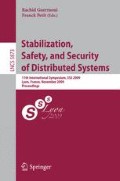Abstract
A wireless sensor network is a set of nodes, each is equipped with sensors and a wireless communication device. Cached Sensornet Transform (CST for short) is a methodology for design and implementation of self-stabilizing algorithms for sensor networks. It transforms a self-stabilizing algorithm in the abstract computational model to a program for sensor networks. In the literature, only CST transformation of silent self-stabilizing algorithms have been investigated, while non-silent ones have not been investigated. Our contribution in this paper is threefold. We present a counterexample of a non-silent algorithm transformed by CST that does not behave correctly despite the original algorithm is correct. We show a sufficient condition for original algorithms and networks such that a transformed algorithm by CST behaves correctly. We present a token circulation algorithm that behaves correctly by CST, and derive upper bound of its expected convergence time.
Access this chapter
Tax calculation will be finalised at checkout
Purchases are for personal use only
Preview
Unable to display preview. Download preview PDF.
References
Dijkstra, E.: Self-stabilizing systems in spite of distributed control. Communications of the ACM 17(11), 643–644 (1974)
Mizuno, M., Kakugawa, H.: A transformation of self-stabilizing programs for distributed computing environments. In: Babaoğlu, Ö., Marzullo, K. (eds.) WDAG 1996. LNCS, vol. 1151, pp. 304–321. Springer, Heidelberg (1996)
Kulkarni, S.S., Arumugam, M.: Transformations for write-all-with-collision model. Computer Communications 29(2), 183–199 (2006)
Huang, S.T., Wuu, L.C., Tsai, M.S.: Distributed execution model for self-stabilizing systems. In: ICDCS, pp. 432–439 (1994)
Herman, T.: Models of self-stabilization and sensor networks. In: Das, S.R., Das, S.K. (eds.) IWDC 2003. LNCS, vol. 2918, pp. 205–214. Springer, Heidelberg (2003)
Turau, V., Weyer, C.: Fault tolerance in wireless sensor networks through self-stabilization. International Journal of Communication Networks and Distributed Systems 2(1), 78–98 (2009)
Kakugawa, H., Masuzawa, T.: Convergence time analysis of self-stabilizing algorithms in wireless sensor networks with unreliable links. In: Kulkarni, S., Schiper, A. (eds.) SSS 2008. LNCS, vol. 5340, pp. 173–187. Springer, Heidelberg (2008)
Yoshida, K., Kakugawa, H., Masuzawa, T.: Observation on lightweight implementation of self-stabilizing node clustering algorithms in sensor networks. In: IASTED SN, Crete, Greece (2008)
Gradinariu, M., Tixeuil, S.: Conflict managers for self-stabilization without fairness assumption. In: ICDCS, p. 46 (2007)
Burns, J.E., Pachl, J.: Uniform self-stabilizing rings. ACM Transactions on Programming Languages and Systems 11(2), 330–344 (1989)
Datta, A.K., Gradinariu, M., Tixeuil, S.: Self-stabilizing mutual exclusion using unfair distributed scheduler. The Computer Journal 47(3), 289–298 (2004)
Author information
Authors and Affiliations
Editor information
Editors and Affiliations
Rights and permissions
Copyright information
© 2009 Springer-Verlag Berlin Heidelberg
About this paper
Cite this paper
Kakugawa, H., Yamauchi, Y., Kamei, S., Masuzawa, T. (2009). Cached Sensornet Transformation of Non-silent Self-stabilizing Algorithms with Unreliable Links. In: Guerraoui, R., Petit, F. (eds) Stabilization, Safety, and Security of Distributed Systems. SSS 2009. Lecture Notes in Computer Science, vol 5873. Springer, Berlin, Heidelberg. https://doi.org/10.1007/978-3-642-05118-0_30
Download citation
DOI: https://doi.org/10.1007/978-3-642-05118-0_30
Publisher Name: Springer, Berlin, Heidelberg
Print ISBN: 978-3-642-05117-3
Online ISBN: 978-3-642-05118-0
eBook Packages: Computer ScienceComputer Science (R0)

